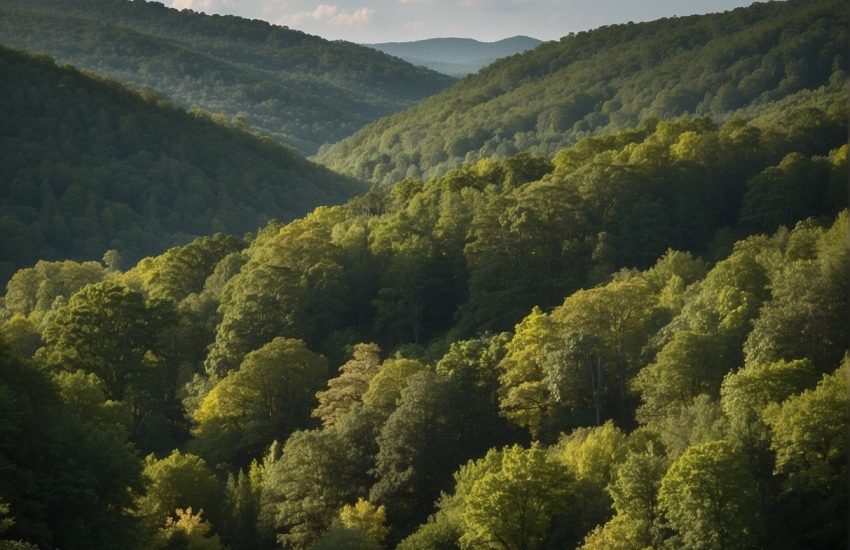Maple Trees in Tennessee: A Guide to Species and Locations
Maple trees are a common sight in Tennessee, adding vibrant colors to the state’s landscape. These deciduous trees are known for their stunning fall foliage, with leaves turning shades of red, orange, and yellow. Tennessee is home to several species of maple trees, each with its unique characteristics.

One of the most common maple trees found in Tennessee is the sugar maple. This tree is known for its sweet sap, which is used to make maple syrup. Sugar maples can grow up to 100 feet tall and have a dense crown of leaves. Another popular species is the red maple, which is known for its stunning red leaves in the fall. Red maples are adaptable to a variety of soil types and can grow in both wet and dry conditions.
Overall, maple trees play an important role in Tennessee’s ecosystem and add beauty to the state’s natural surroundings. Whether you’re admiring their fall colors or tapping their sap for syrup, these trees are a beloved part of Tennessee’s landscape.
Native Maple Trees in Tennessee

Tennessee is home to several native species of maple trees, which provide beautiful foliage and shade throughout the state. These trees are well-adapted to the climate and soil conditions of the Volunteer State, making them a popular choice for gardeners and landscapers.
Red Maple (Acer Rubrum)
The Red Maple, also known as Acer Rubrum, is a common sight in Tennessee. This tree is known for its stunning red foliage in the fall, which makes it a popular choice for landscaping. The leaves of the Red Maple are usually three to five-lobed and have a distinctive red color, which can vary in intensity depending on the tree’s location and the weather conditions.
Sugar Maple (Acer Saccharum)
The Sugar Maple, also known as Acer Saccharum, is another native species of maple tree found in Tennessee. This tree is known for its beautiful fall foliage, which can range from yellow to orange to red. The leaves of the Sugar Maple are usually five-lobed and have a distinctive shape that makes them easy to identify.
Silver Maple (Acer Saccharinum)
The Silver Maple, also known as Acer Saccharinum, is a fast-growing tree that is well-suited to Tennessee’s climate. This tree is known for its silver-gray bark and distinctive foliage, which can range from green to silver in color. The leaves of the Silver Maple are usually five-lobed and have a distinctive shape that makes them easy to identify.
Box Elder (Acer Negundo)
The Box Elder, also known as Acer Negundo, is a small to medium-sized tree that is found throughout Tennessee. This tree is known for its distinctive foliage, which can range from green to yellow to red in color. The leaves of the Box Elder are usually three to five-lobed and have a distinctive shape that makes them easy to identify.
Overall, the native maple trees of Tennessee are a beautiful and important part of the state’s landscape. Whether you are a gardener, landscaper, or just enjoy the beauty of fall foliage, these trees are sure to impress.
Cultivating Maple Trees in Tennessee
Planting and Maintenance
Maple trees are a popular choice for landscaping in Tennessee due to their fast-growing nature and low-maintenance requirements. When planting a maple tree, it is important to choose a variety that is well-suited to the growing climate and soil conditions of Tennessee. Some popular varieties of maple trees that grow well in Tennessee include the Japanese maple (Acer palmatum), the Autumn Blaze maple (Acer x freemanii ‘Jeffersred’), and the Sycamore maple (Acer pseudoplatanus).
To ensure successful growth, it is important to plant maple trees in well-draining soil that is moderately moist. If the soil is clay-based, it may be necessary to till the soil and add organic matter to improve drainage. Maple trees should be spaced at least 20 feet apart to allow for proper canopy growth and to prevent overcrowding.
Proper watering and fertilization are also important for maintaining healthy maple trees. Newly planted trees should be watered regularly, especially during the early spring growing season. Fertilization should be done in the early spring using a slow-release fertilizer that is high in nitrogen.
Regular pruning is also important for maintaining the shape and health of maple trees. Pruning should be done in the late winter or early spring before new growth begins. Dead or damaged branches should be removed, and the canopy should be thinned to allow for proper air circulation.
Maple Tree Varieties and Their Uses
There are many different varieties of maple trees that are well-suited to the growing conditions in Tennessee. Some common varieties include the Japanese maple, the Autumn Blaze maple, and the Sycamore maple.
The Japanese maple is a popular choice for landscaping due to its vibrant green foliage and delicate flowers. This variety is well-suited to urban areas and can be grown in containers or as a small shade tree.
The Autumn Blaze maple is a hybrid variety that is known for its brilliant fall foliage and fast growth rate. This variety is well-suited to larger landscapes and can be used as a shade tree or for ornamental purposes.
The Sycamore maple is a hardy variety that is well-suited to a variety of growing conditions. This variety is often used in urban settings due to its adaptability and low-maintenance requirements.
In addition to their ornamental value, some varieties of maple trees are also used for their sap, which can be harvested to make maple syrup. The sugar maple (Acer saccharum) is the most commonly used variety for maple syrup production, but other varieties such as the Black maple (Acer nigrum) and the Red maple (Acer rubrum) can also be used.
Overall, maple trees are a great choice for landscaping in Tennessee due to their adaptability, low-maintenance requirements, and ornamental value. By choosing the right variety and providing proper care, homeowners can enjoy the beauty and benefits of maple trees for years to come.


